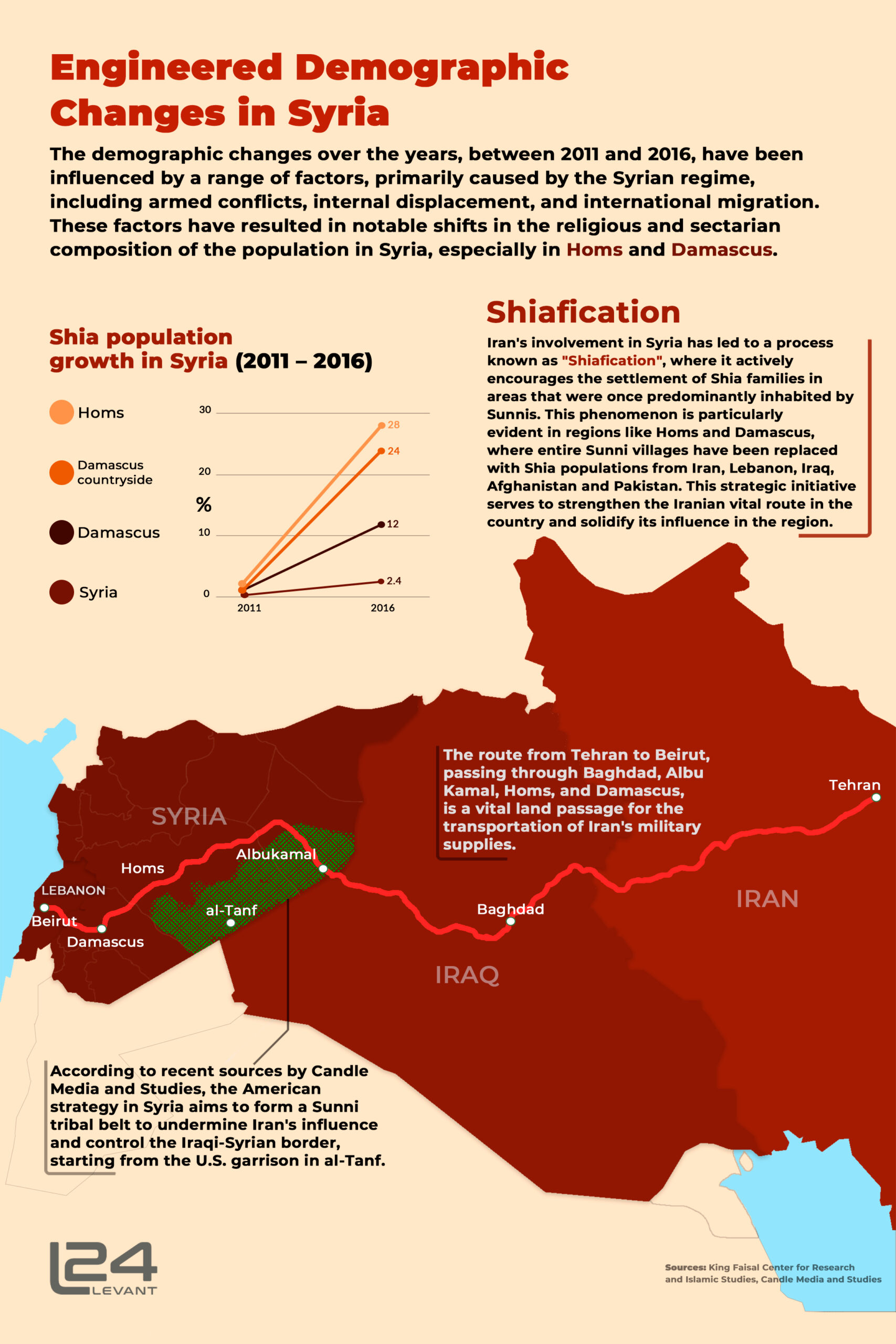
On June 14, the world witnessed a tragic incident as a ship off the Greek coast sank in the Mediterranean. Among the passengers, over 120 were from Syria, with more than 80 from Daraa, an area under the control of the Assad regime. This raises the question: why would Syrians still be compelled to leave their homes and risk their lives despite promises of refugee returns and normalization?
Could it be that the regime’s military, security, and legal strategies are intentionally designed to drive Syrians out of their country and homes? Is it an attempt to alter the demography, seize land and property, and discourage the return of internally and externally displaced Syrians?
Demography and the Concept of ‘Useful Syria’
In a 2017 speech to the Foreign and Expatriates Ministry, Assad commented on the depopulation of significant parts of the country, stating, “Syria has lost its youth and infrastructure, [but] it has won a healthier and more homogeneous society.” By this, he meant a Syria purged of individuals who opposed his oppressive rule. In early 2016, Assad expressed his intention to focus on what he referred to as “Useful Syria,” consisting of six governorates: Damascus and its countryside, Hama, Homs, Latakia, and Tartus. By the end of 2016, with support from his Russian and Iranian allies, he had significantly transformed the demographic makeup of these provinces.
According to a study by Hussain Qutrib, an Associate Professor of Geomorphology, Assad’s efforts to alter the demography of “Useful Syria” resulted in a nearly 50% reduction in the Sunni Muslim population in the six regions, from around 6.8 million to 3.9 million. Meanwhile, there was over a tenfold increase in the Shiite population, primarily composed of individuals from Iran, Iraq, and Lebanon, growing from 92,000 to over a million.

The regime implemented a policy of preventing Sunnis from returning to their homes, instead replacing them with Alawite and Shiite families, from Iran, Iraq, and Lebanon who occupied the vacated areas, with the regime granting them citizenship to reside in one of the six provinces. Assad justified his policy of naturalizing his political supporters by stating, “Syria is for those who defend it, not those who hold its passport.”
Karam al-Khatib, who was expelled from his home in the Damascus countryside and forced to flee to northern Syria, recounted his experience to L24, saying, “I left my home due to forced displacement by the Assad forces and Iranian militias. I was compelled to leave under the threat of being killed if I stayed.” His story is not unique, as thousands of others have faced similar situations.
Not Solely Assad’s Responsibility…
Fadel Abdul Ghany, the director of the Syrian Network for Human Rights (SNHR), emphasized that other parties have also contributed to violations leading to displacement and migration, affecting millions of people.
Enforced displacement was not exclusively carried out by the Assad regime; countries like Turkey, Russia, and Iran also participated in “negotiated” transfers of entire villages and towns, often following years of siege and bombardment. Examples include the population swaps of Madaya, Zabadani, Foua, and Kefraya, as well as the displacement of Arabs from Damascus, Homs, and Hama to Afrin.
According to Professor Qutrib, Russia was responsible for a campaign in Latakia that resulted in the killing or displacement of 95% of the Turkmen population, leading Turkey to accuse them of ethnic cleansing. Iranian efforts can be observed in the significant increase of Shiites, particularly those of Iranian and Iraqi origins, in formerly Sunni Arab districts, neighborhoods, and villages.
Non-state actors, have contributed to this, such as the translocation of predominantly Alawite and Shiite villages, Foua, Kefraya, and Ishtabraq in Idlib province for those in Yarmouk camp near Damascus, by several revolutionary factions or the well documented campaign of ISIS against the Yazidi.
Significant demographic changes occurred in northern Syria by the predominantly Kurdish Syrian Democratic Forces (SDF). The SDF displaced mainly Arabs, often accusing them of being affiliated with ISIS, as well as Kurdish political opponents throughout northeastern Syria. Human rights groups have documented SDF displacing residents in 14 areas, including Raqqa’s countryside, Hasaka, Tal Abyadh, and Tal Rifaat, where many Arabs and Turkmen were expelled and replaced by Kurdish SDF members or their families.
“Forced displacement is a widespread issue,” states SNHR’s Abdul Ghany. “While the violations committed by other parties are fewer than those of the regime, they still constitute war crimes, whereas the regime’s violations amount to crimes against humanity and are more extensive.”
Ethnic Cleansing?
The Assad regime has faced accusations of ethnic and sectarian cleansing for deliberately displacing specific ethnic or sectarian groups through violent attacks, intimidation, siege warfare, and scorched-earth tactics. By altering the demography, Assad aims to consolidate control over territories and weaken his opposition.
Abdul Ghany, holding a LLM in International Law, explains that although displacement carried out by the regime constitutes a crime against humanity due to its widespread, deliberate, and systematic nature, it does not meet the legal definition of ethnic cleansing, despite the presence of “racial or sectarian undertones.”

Dr. Chatty emphasizes that while displacement alone may be seen as a consequence of war, the intentions of violating parties, such as the Assad regime, may become evident in the post-conflict period through their willingness to allow the displaced to safely return and reclaim their land, homes, and properties.
Land and Property Divestment
A tactic employed to prevent the return of displaced populations is ensuring there is nothing left to return to. This is achieved by completely demolishing homes and neighborhoods or through administrative theft facilitated by the creation of a “legal” framework. The regime fosters a culture of obstruction and intimidation, making return and the recovery of land and homes nearly impossible.

Reconstruction is often used as a pretext, as Abdulrahman further elucidates, “The law permits the establishment of one or more zoning areas… under the pretext of rebuilding the completely destroyed cities.” Former residents in these areas are given a limited time, ranging from one month to one year, to return to government-controlled areas and prove their ownership or forfeit all rights.
Many property owners lost documents, had them stolen at checkpoints or from their homes, or destroyed during bombardment. The regime has deliberately destroyed paperwork in many areas by burning deeds, local registries, and archives.
“I have great doubts that many people will succeed in registering and re-registering their property,” remarks Professor Chatty. Since 2012, the regime has actively developed a legislative framework aimed at divesting Assad’s political opponents of their property rights, effectively making the confiscation of land, buildings, and wealth “legal.”
Insecurity and Intimidation
Massacres, arrests, torture, rape and sexual violence, enforced disappearance, and extrajudicial killings are all employed by Assad and his supporters to displace residents and prevent their return. “No one I know has returned due to the lack of security in my area and immediate arrests upon return,” states al-Khatib, an internally displaced person from rural Damascus.
Abdul Ghany affirms many Syrians feel threatened and terrified of being targeted by the regime and don’t dare risk returning due to “the presence of these forces that commit the worst types of violations against civilians in the areas they control.”
Addressing the Issue at Its Root
Millions of Syrians have been forced to flee, seeking refuge in safer parts of Syria or abroad. The systematic pattern of displacement and demographic change perpetuated by the Assad regime aims to weaken opposition forces, consolidate control, and establish economic and political power.
“The solutions,” Abdulrahman suggests, “lie in addressing the causes of the refugee crisis and changing the Syrian regime. Refugees will not return to their homeland if it continues to be a place of injustice and oppression.”

Displacement of Syrians, isn’t an unintended consequence of the prolonged conflict. It is the result of intentional policies of the Assad regime, intended to create a Syria comprised solely of those who serve and support the regime. Addressing this crisis, requires a comprehensive solution that involves political change, respect for human and property rights, and ensuring the safety and security of the existing and displaced populations.









